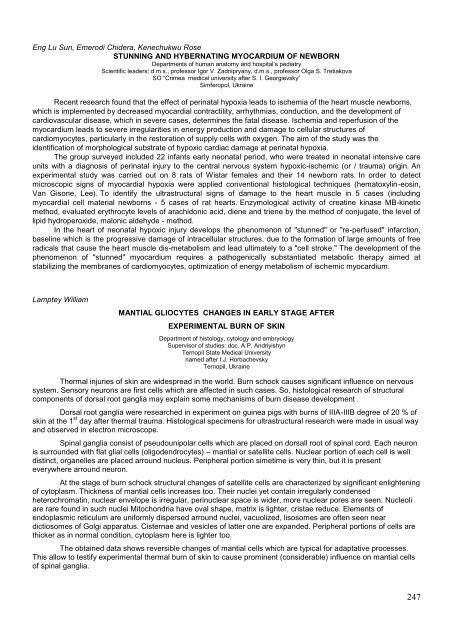ÐбÑÑник Ñез XVI ÐÑжнаÑодно медиÑного конгÑеÑÑ ÑÑÑденÑÑв Ñа ...
ÐбÑÑник Ñез XVI ÐÑжнаÑодно медиÑного конгÑеÑÑ ÑÑÑденÑÑв Ñа ...
ÐбÑÑник Ñез XVI ÐÑжнаÑодно медиÑного конгÑеÑÑ ÑÑÑденÑÑв Ñа ...
Create successful ePaper yourself
Turn your PDF publications into a flip-book with our unique Google optimized e-Paper software.
Eng Lu Sun, Emerodi Chidera, Kenechukwu Rose<br />
STUNNING AND HYBERNATING MYOCARDIUM OF NEWBORN<br />
Departments of human anatomy and hospital‘s pediatry<br />
Scientific leaders: d.m.s., professor Igor V. Zadnipryany, d.m.s., professor Olga S. Tretiakova<br />
SO ―Crimea medical university after S. I. Georgievsky‖<br />
Simferopol, Ukraine<br />
Recent research found that the effect of perinatal hypoxia leads to ischemia of the heart muscle newborns,<br />
which is implemented by decreased myocardial contractility, arrhythmias, conduction, and the development of<br />
cardiovascular disease, which in severe cases, determines the fatal disease. Ischemia and reperfusion of the<br />
myocardium leads to severe irregularities in energy production and damage to cellular structures of<br />
cardiomyocytes, particularly in the restoration of supply cells with oxygen. The aim of the study was the<br />
identification of morphological substrate of hypoxic cardiac damage at perinatal hypoxia.<br />
The group surveyed included 22 infants early neonatal period, who were treated in neonatal intensive care<br />
units with a diagnosis of perinatal injury to the central nervous system hypoxic-ischemic (or / trauma) origin. An<br />
experimental study was carried out on 8 rats of Wistar females and their 14 newborn rats. In order to detect<br />
microscopic signs of myocardial hypoxia were applied conventional histological techniques (hematoxylin-eosin,<br />
Van Gisone, Lee). To identify the ultrastructural signs of damage to the heart muscle in 5 cases (including<br />
myocardial cell material newborns - 5 cases of rat hearts. Enzymological activity of creatine kinase MB-kinetic<br />
method, evaluated erythrocyte levels of arachidonic acid, diene and triene by the method of conjugate, the level of<br />
lipid hydroperoxide, malonic aldehyde - method.<br />
In the heart of neonatal hypoxic injury develops the phenomenon of "stunned" or "re-perfused" infarction,<br />
baseline which is the progressive damage of intracellular structures, due to the formation of large amounts of free<br />
radicals that cause the heart muscle dis-metabolism and lead ultimately to a "cell stroke." The development of the<br />
phenomenon of "stunned" myocardium requires a pathogenically substantiated metabolic therapy aimed at<br />
stabilizing the membranes of cardiomyocytes, optimization of energy metabolism of ischemic myocardium.<br />
Lamptey William<br />
MANTIAL GLIOCYTES CHANGES IN EARLY STAGE AFTER<br />
EXPERIMENTAL BURN OF SKIN<br />
Department of histology, cytology and embryology<br />
Supervisor of studies: doc. A.P. Andriyishyn<br />
Ternopil State Medical University<br />
named after I.J. Horbachevsky<br />
Ternopil, Ukraine<br />
Thermal injuries of skin are widespread in the world. Burn schock causes significant influence on nervous<br />
system. Sensory neurons are first cells which are affected in such cases. So, histological research of structural<br />
components of dorsal root ganglia may explain some mechanisms of burn disease development .<br />
Dorsal root ganglia were researched in experiment on guinea pigs with burns of IIIA-IIIB degree of 20 % of<br />
skin at the 1 st day after thermal trauma. Histological specimens for ultrastructural research were made in usual way<br />
and observed in electron microscope.<br />
Spinal ganglia consist of pseudounipolar cells which are placed on dorsall root of spinal cord. Each neuron<br />
is surrounded with flat glial cells (oligodendrocytes) – mantial or satellite cells. Nuclear portion of each cell is well<br />
distinct, organelles are placed arround nucleus. Peripheral portion simetime is very thin, but it is present<br />
everywhere arround neuron.<br />
At the stage of burn schock structural changes of satellite cells are characterized by significant enlightening<br />
of cytoplasm. Thickness of mantial cells increases too. Their nuclei yet contain irregularly condensed<br />
heterochromatin, nuclear envelope is irregular, perinuclear space is wider, more nuclear pores are seen. Nucleoli<br />
are rare found in such nuclei Mitochondria have oval shape, matrix is lighter, cristae reduce. Elements of<br />
endoplasmic reticulum are uniformly dispersed arround nuclei, vacuolized, lisosomes are often seen near<br />
dictiosomes of Golgi apparatus. Cisternae and vesicles of latter one are expanded. Peripheral portions of cells are<br />
thicker as in normal condition, cytoplasm here is lighter too.<br />
The obtained data shows reversible changes of mantial cells which are typical for adaptative processes.<br />
This allow to testify experimental thermal burn of skin to cause prominent (considerable) influence on mantial cells<br />
of spinal ganglia.<br />
247
















